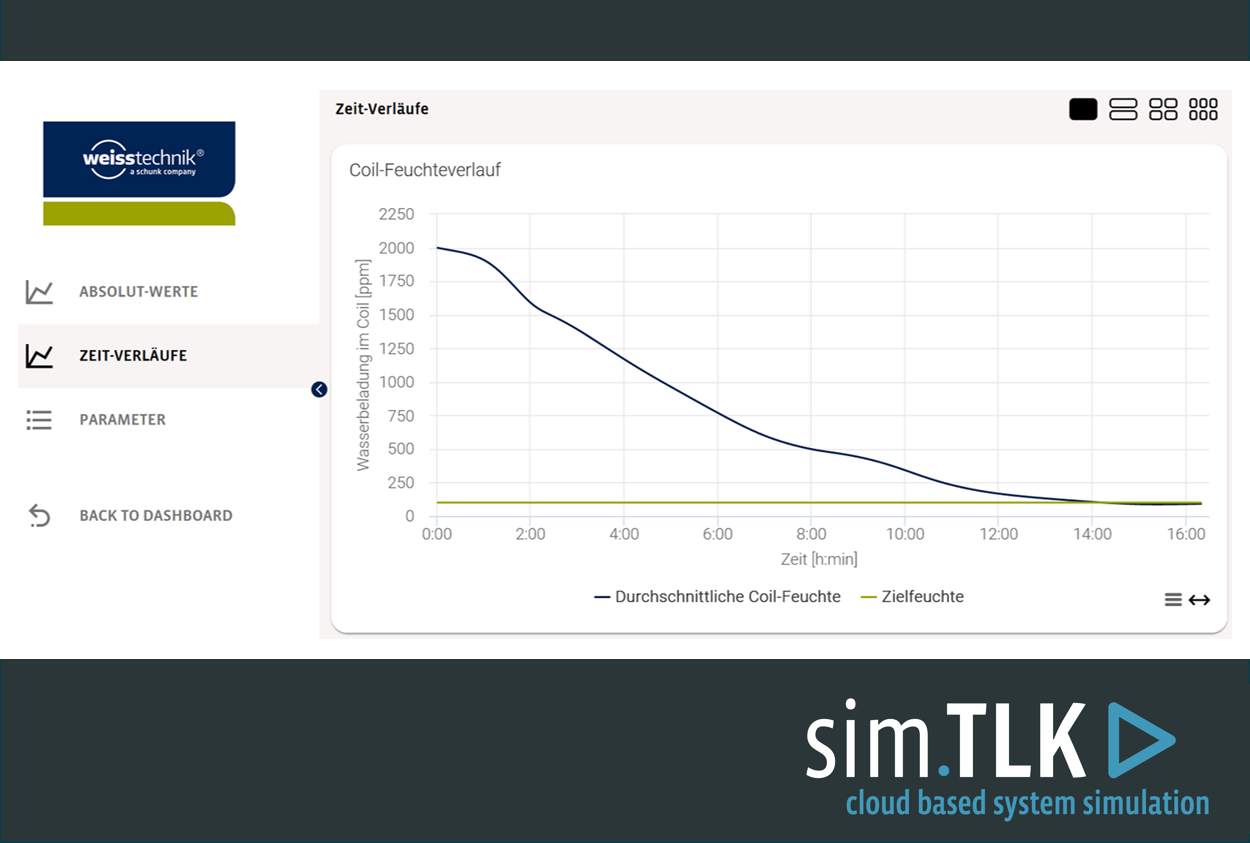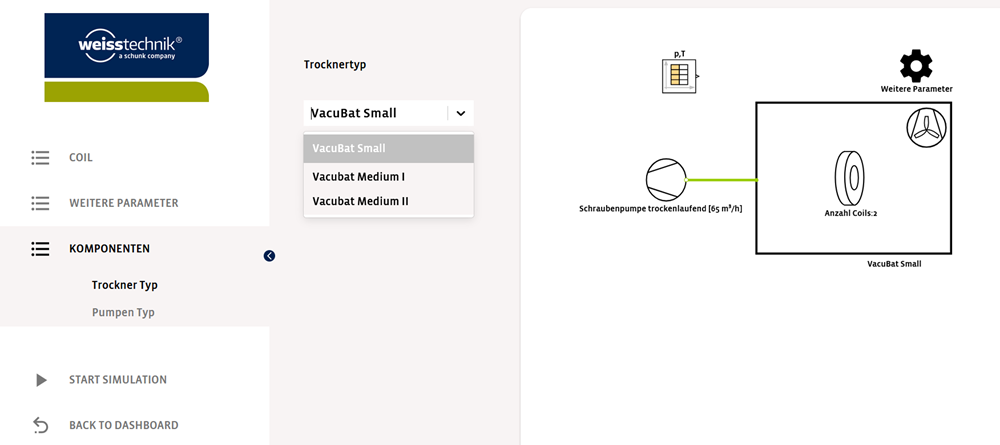Customer Success Story: TLK Energy developed a customized sim.TLK App for Weiss Technik. The web simulator makes the configuration of vacuum dryers transparent, reduces effort in sales, and increases efficiency in design and development – practical and customer-oriented.

-
Vacuum drying is an efficient and gentle drying method used not only in the food industry but also in battery cell production. For this purpose, Weiss Technik provides turnkey systems and develops customized, process-optimized vacuum drying solutions for efficient and safe battery manufacturing. The following article offers an insight into the work of Weiss Technik and our joint project. To support technical sales, we created a web-based simulator using our model libraries and the sim.TLK platform. With this tool, sales representatives can configure systems according to customer requirements and immediately receive a detailed thermodynamic overview of the system. At the end of this article, we take a closer look at vacuum drying in general, explain the underlying physical principle, and highlight its wide range of applications.
The term coils refers to the wound electrodes that are manufactured and further processed for the production of lithium-ion batteries. During production, electrode foils are coated with a mixture that contains, among other components, active material and solvent. The foils are then rolled into cylindrical shapes and dried. The dryness of the coils plays a decisive role in the performance and longevity of the batteries, making the drying process highly important – the rule is: the drier, the better. To achieve thorough drying with minimal time and energy consumption, vacuum drying is an excellent method.

„Electrode post-drying is one of the core processes in battery cell production. The web simulator developed by TLK Energy already supports us during the quotation and planning phases by enabling us to quickly and efficiently offer our customers the optimal system configuration tailored to their specific production parameters.“
— Katharina Mayer, Application Manager E-Mobility at Weiss Technik
Drying in a vacuum dryer from Weiss Technik offers a vast range of possibilities for adjusting the drying process due to numerous variable factors.
In general, these factors can be divided into two categories:
1. Component configuration
This includes, among others:
2. Process control
This includes, for example:
The multitude and interaction of these factors make manual optimization nearly impossible. To identify the ideal configuration for the defined objectives—such as achieving a specific drying time with minimal energy consumption—and at the same time provide the customer with an understanding of the overall system, the web-based simulation of vacuum drying with sim.TLK is used.
Our simulation model is built using the object-oriented modeling language Modelica and is based on the models from our TIL Suite library. It represents all relevant core components and physical phenomena of vacuum coil drying.
Key model components
Considered physical phenomena
The model allows for free parameterization of all process variables such as geometries, process profiles, and materials. In addition, it provides an option for automated process control based on sensors and safety routines for handling flammable solvents.

With sim.TLK to a customized web simulator in the browser
The sim.TLK App, developed specifically for Weiss Technik, is accessible directly via browser login. The foundation for creating these web-based simulators is our simulation platform sim.TLK. The appearance was adapted to Weiss Technik’s corporate design, and the desired functions were implemented in a customized manner.
Compared to traditional software environments, the browser-based solution offers decisive advantages:
How versatile the sim.TLK App can be in practice is demonstrated by the following use cases from our joint project with Weiss Technik.
When designing customer-specific vacuum dryers, Weiss Technik offers a wide selection of vacuum dryer components that can be flexibly combined into customized system configurations.
Variety of vacuum dryer components
Simulation as a decision-making tool
The customized web simulator makes it possible to virtually combine all these components and calculate complete vacuum dryer configurations. This enables rapid evaluation of different variants – from efficiency to energy demand – in the shortest possible time.

From input to optimal configuration
The customized sim.TLK App is accessible via browser login. To create a tailored system configuration, the user first enters the key process and component parameters online:
These inputs form the basis for the calculation using dynamic online simulation.
Automated calculation of all relevant key figures
Based on the selected components and process parameters, the sim.TLK App generates a comprehensive analysis. The evaluation metrics were defined in collaboration with the customer and include, among others:
These results are presented to the user directly in the browser through interactive diagrams and clearly structured tables.
Customer benefits in the sales process
This not only accelerates the decision-making process but also provides the customer with a clear understanding of the overall system already during the planning phase.

In addition to selecting the optimal component combination, the sim.TLK App is also well suited for a second important application: the optimization of process control.
Influencing factors on the drying process
The course of temperature and pressure – and thus the boiling point – as well as the moisture concentration in the gas and the flow velocity, have a significant impact on:
These complex interactions can be specifically analyzed and varied within the web simulator.
Static process control
In a static process control mode, users can define fixed pressure and temperature profiles in the simulator, as well as specify the conditions under which the fan in the vacuum dryer is activated (see Figure 4). The pressure profile indirectly controls the moisture behavior in the gas: each time the vacuum dryer is purged with dry inert gas, the largest possible moisture difference between the coil and the gas is created – a key driver for mass transfer.
Dynamic process control
For dynamic process control, the sim.TLK App developed for Weiss Technik simulates the use of a humidity sensor in the gas. This sensor measures the moisture content and thus indirectly the drying rate within the coil. Based on this data, various control strategies can be implemented, such as:
As a result, the gas atmosphere remains consistently within a desired humidity range, ensuring a stable moisture gradient between the coil and the gas.
Benefits for sales and R&D
While static process control can primarily be used for customer consultation in sales, dynamic process control offers tremendous additional potential for research and development. Initial insights can be gained without costly and time-consuming experimental series – a clear advantage in the development of new processes.

Drying, in general, refers to the removal of liquid from a material. To make this process – especially in technical applications – more efficient and gentle, vacuum drying has become an established method. It enables rapid drying at significantly lower temperatures compared to conventional techniques.
Typical fields of application
Vacuum drying is used across many industries, including:
The physical principle
The basic principle of vacuum drying is based on lowering the boiling temperature by reducing the pressure. The boiling point describes the condition at which a substance changes from the liquid to the gaseous state.
In general, the following applies: the lower the pressure, the lower the temperature at which a substance boils.
An example
At atmospheric pressure at sea level (≈ 1 bar), the boiling temperature of water is 100 °C. On Mount Everest, however, the pressure is only about 0.3 bar – there, water boils at around 70 °C (see Figure 5).
This means that in a vacuum, water (and thus residual moisture in materials) requires much less heating to evaporate. This enables particularly energy-efficient and gentle drying.

Implementation of vacuum drying
To achieve the pressure reduction required for vacuum drying, a vacuum pump is used to generate a pressure lower than the ambient atmospheric pressure. During this process, the vacuum chamber is heated until the corresponding boiling temperature is reached. The liquid within the material to be dried evaporates and mixes with the gas inside the vacuum chamber. During drying, the moist gas is regularly replaced with dry gas to maintain a constant moisture concentration gradient between the gas and the material. This allows continuous removal of residual moisture.
In addition to the two main components – the heating chamber and the vacuum pump – a vacuum dryer may also include a condenser. The condenser serves to condense and safely collect evaporated and potentially harmful substances, such as solvents, after the drying process.
Advantages of vacuum drying
Compared to conventional drying at ambient pressure, vacuum drying offers several key advantages:
The outcome of vacuum drying depends on numerous influencing factors, such as the temperature and pressure profiles, the geometry of the vacuum dryer, the characteristics of the vacuum pump, and the specific properties of the material being dried. These many factors can be integrated into simulation-based calculations using the sim.TLK App. Dynamic simulation models thus provide a fast and cost-effective way to realistically represent and analyze technical systems and processes. The web-based simulator for component selection and development of Weiss Technik vacuum dryers impressively demonstrates how simulation can save time, reduce costs, and make customer processes more transparent.
If you are also interested in a customized simulation model or a sim.TLK App for your technical system, feel free to try out the free demo version of sim.TLK. Or schedule an initial consultation directly – we look forward to hearing from you!